Ndivhuwo Makondo
Few-shot Policy (de)composition in Conversational Question Answering
Jan 20, 2025



Abstract:The task of policy compliance detection (PCD) is to determine if a scenario is in compliance with respect to a set of written policies. In a conversational setting, the results of PCD can indicate if clarifying questions must be asked to determine compliance status. Existing approaches usually claim to have reasoning capabilities that are latent or require a large amount of annotated data. In this work, we propose logical decomposition for policy compliance (LDPC): a neuro-symbolic framework to detect policy compliance using large language models (LLMs) in a few-shot setting. By selecting only a few exemplars alongside recently developed prompting techniques, we demonstrate that our approach soundly reasons about policy compliance conversations by extracting sub-questions to be answered, assigning truth values from contextual information, and explicitly producing a set of logic statements from the given policies. The formulation of explicit logic graphs can in turn help answer PCDrelated questions with increased transparency and explainability. We apply this approach to the popular PCD and conversational machine reading benchmark, ShARC, and show competitive performance with no task-specific finetuning. We also leverage the inherently interpretable architecture of LDPC to understand where errors occur, revealing ambiguities in the ShARC dataset and highlighting the challenges involved with reasoning for conversational question answering.
Neural Reasoning Networks: Efficient Interpretable Neural Networks With Automatic Textual Explanations
Oct 10, 2024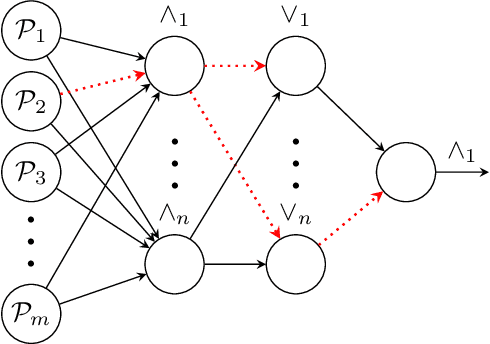

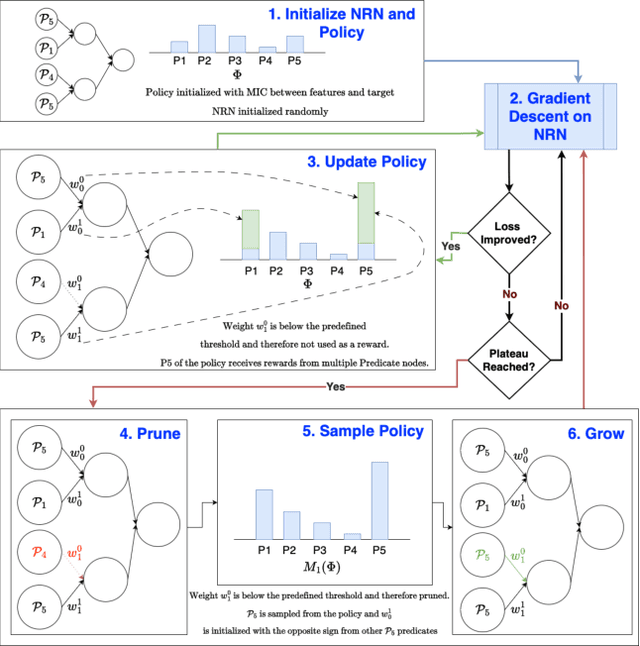

Abstract:Recent advances in machine learning have led to a surge in adoption of neural networks for various tasks, but lack of interpretability remains an issue for many others in which an understanding of the features influencing the prediction is necessary to ensure fairness, safety, and legal compliance. In this paper we consider one class of such tasks, tabular dataset classification, and propose a novel neuro-symbolic architecture, Neural Reasoning Networks (NRN), that is scalable and generates logically sound textual explanations for its predictions. NRNs are connected layers of logical neurons which implement a form of real valued logic. A training algorithm (R-NRN) learns the weights of the network as usual using gradient descent optimization with backprop, but also learns the network structure itself using a bandit-based optimization. Both are implemented in an extension to PyTorch (https://github.com/IBM/torchlogic) that takes full advantage of GPU scaling and batched training. Evaluation on a diverse set of 22 open-source datasets for tabular classification demonstrates performance (measured by ROC AUC) which improves over multi-layer perceptron (MLP) and is statistically similar to other state-of-the-art approaches such as Random Forest, XGBoost and Gradient Boosted Trees, while offering 43% faster training and a more than 2 orders of magnitude reduction in the number of parameters required, on average. Furthermore, R-NRN explanations are shorter than the compared approaches while producing more accurate feature importance scores.
Alignment Studio: Aligning Large Language Models to Particular Contextual Regulations
Mar 08, 2024Abstract:The alignment of large language models is usually done by model providers to add or control behaviors that are common or universally understood across use cases and contexts. In contrast, in this article, we present an approach and architecture that empowers application developers to tune a model to their particular values, social norms, laws and other regulations, and orchestrate between potentially conflicting requirements in context. We lay out three main components of such an Alignment Studio architecture: Framers, Instructors, and Auditors that work in concert to control the behavior of a language model. We illustrate this approach with a running example of aligning a company's internal-facing enterprise chatbot to its business conduct guidelines.
An Ensemble Approach for Automated Theorem Proving Based on Efficient Name Invariant Graph Neural Representations
May 15, 2023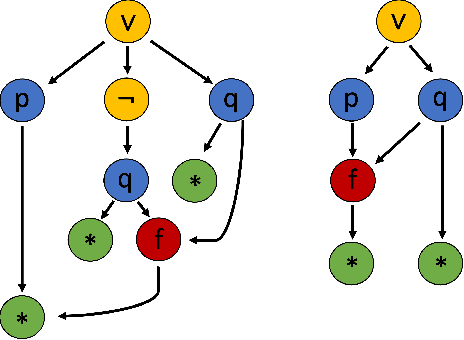
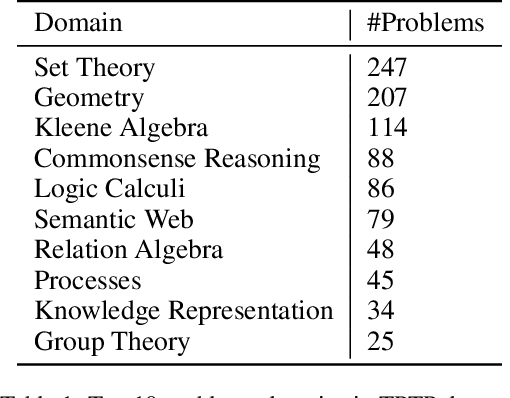
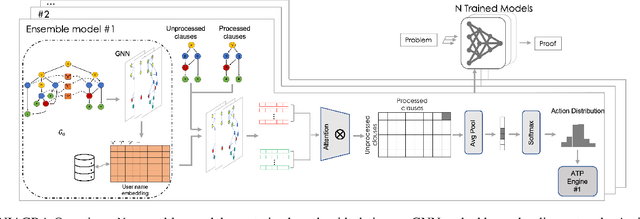

Abstract:Using reinforcement learning for automated theorem proving has recently received much attention. Current approaches use representations of logical statements that often rely on the names used in these statements and, as a result, the models are generally not transferable from one domain to another. The size of these representations and whether to include the whole theory or part of it are other important decisions that affect the performance of these approaches as well as their runtime efficiency. In this paper, we present NIAGRA; an ensemble Name InvAriant Graph RepresentAtion. NIAGRA addresses this problem by using 1) improved Graph Neural Networks for learning name-invariant formula representations that is tailored for their unique characteristics and 2) an efficient ensemble approach for automated theorem proving. Our experimental evaluation shows state-of-the-art performance on multiple datasets from different domains with improvements up to 10% compared to the best learning-based approaches. Furthermore, transfer learning experiments show that our approach significantly outperforms other learning-based approaches by up to 28%.
An Analysis of Reinforcement Learning for Malaria Control
Jul 19, 2021



Abstract:Previous work on policy learning for Malaria control has often formulated the problem as an optimization problem assuming the objective function and the search space have a specific structure. The problem has been formulated as multi-armed bandits, contextual bandits and a Markov Decision Process in isolation. Furthermore, an emphasis is put on developing new algorithms specific to an instance of Malaria control, while ignoring a plethora of simpler and general algorithms in the literature. In this work, we formally study the formulation of Malaria control and present a comprehensive analysis of several formulations used in the literature. In addition, we implement and analyze several reinforcement learning algorithms in all formulations and compare them to black box optimization. In contrast to previous work, our results show that simple algorithms based on Upper Confidence Bounds are sufficient for learning good Malaria policies, and tend to outperform their more advanced counterparts on the malaria OpenAI Gym environment.
Learning to Guide a Saturation-Based Theorem Prover
Jun 07, 2021
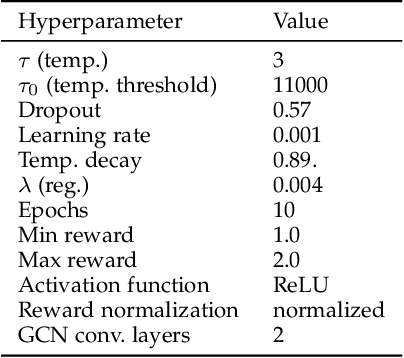


Abstract:Traditional automated theorem provers have relied on manually tuned heuristics to guide how they perform proof search. Recently, however, there has been a surge of interest in the design of learning mechanisms that can be integrated into theorem provers to improve their performance automatically. In this work, we introduce TRAIL, a deep learning-based approach to theorem proving that characterizes core elements of saturation-based theorem proving within a neural framework. TRAIL leverages (a) an effective graph neural network for representing logical formulas, (b) a novel neural representation of the state of a saturation-based theorem prover in terms of processed clauses and available actions, and (c) a novel representation of the inference selection process as an attention-based action policy. We show through a systematic analysis that these components allow TRAIL to significantly outperform previous reinforcement learning-based theorem provers on two standard benchmark datasets (up to 36% more theorems proved). In addition, to the best of our knowledge, TRAIL is the first reinforcement learning-based approach to exceed the performance of a state-of-the-art traditional theorem prover on a standard theorem proving benchmark (solving up to 17% more problems).
Logic Embeddings for Complex Query Answering
Feb 28, 2021Abstract:Answering logical queries over incomplete knowledge bases is challenging because: 1) it calls for implicit link prediction, and 2) brute force answering of existential first-order logic queries is exponential in the number of existential variables. Recent work of query embeddings provides fast querying, but most approaches model set logic with closed regions, so lack negation. Query embeddings that do support negation use densities that suffer drawbacks: 1) only improvise logic, 2) use expensive distributions, and 3) poorly model answer uncertainty. In this paper, we propose Logic Embeddings, a new approach to embedding complex queries that uses Skolemisation to eliminate existential variables for efficient querying. It supports negation, but improves on density approaches: 1) integrates well-studied t-norm logic and directly evaluates satisfiability, 2) simplifies modeling with truth values, and 3) models uncertainty with truth bounds. Logic Embeddings are competitively fast and accurate in query answering over large, incomplete knowledge graphs, outperform on negation queries, and in particular, provide improved modeling of answer uncertainty as evidenced by a superior correlation between answer set size and embedding entropy.
Question Answering over Knowledge Bases by Leveraging Semantic Parsing and Neuro-Symbolic Reasoning
Dec 03, 2020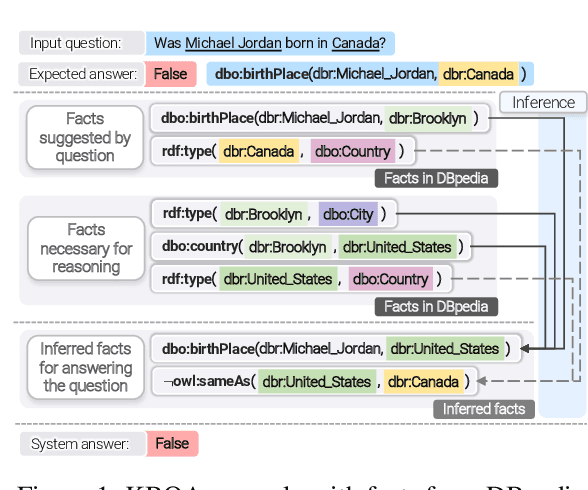
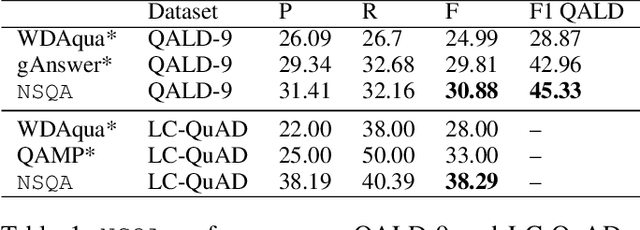
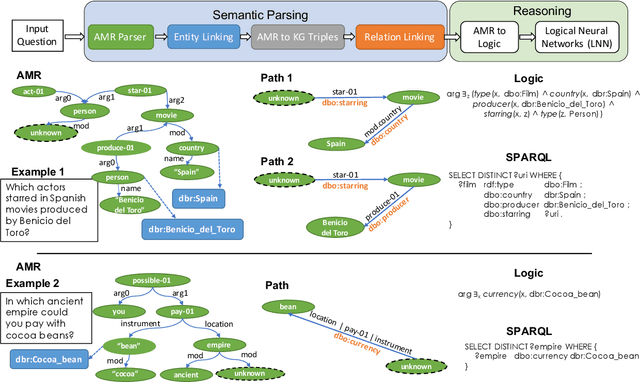

Abstract:Knowledge base question answering (KBQA) is an important task in Natural Language Processing. Existing approaches face significant challenges including complex question understanding, necessity for reasoning, and lack of large training datasets. In this work, we propose a semantic parsing and reasoning-based Neuro-Symbolic Question Answering(NSQA) system, that leverages (1) Abstract Meaning Representation (AMR) parses for task-independent question under-standing; (2) a novel path-based approach to transform AMR parses into candidate logical queries that are aligned to the KB; (3) a neuro-symbolic reasoner called Logical Neural Net-work (LNN) that executes logical queries and reasons over KB facts to provide an answer; (4) system of systems approach,which integrates multiple, reusable modules that are trained specifically for their individual tasks (e.g. semantic parsing,entity linking, and relationship linking) and do not require end-to-end training data. NSQA achieves state-of-the-art performance on QALD-9 and LC-QuAD 1.0. NSQA's novelty lies in its modular neuro-symbolic architecture and its task-general approach to interpreting natural language questions.
Logical Neural Networks
Jun 23, 2020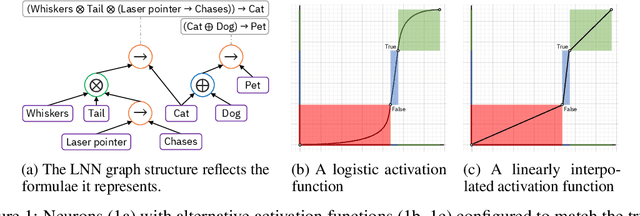

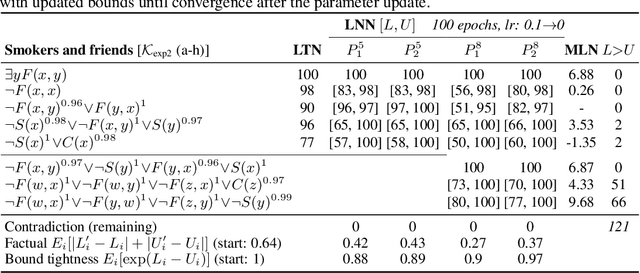

Abstract:We propose a novel framework seamlessly providing key properties of both neural nets (learning) and symbolic logic (knowledge and reasoning). Every neuron has a meaning as a component of a formula in a weighted real-valued logic, yielding a highly intepretable disentangled representation. Inference is omnidirectional rather than focused on predefined target variables, and corresponds to logical reasoning, including classical first-order logic theorem proving as a special case. The model is end-to-end differentiable, and learning minimizes a novel loss function capturing logical contradiction, yielding resilience to inconsistent knowledge. It also enables the open-world assumption by maintaining bounds on truth values which can have probabilistic semantics, yielding resilience to incomplete knowledge.
 Add to Chrome
Add to Chrome Add to Firefox
Add to Firefox Add to Edge
Add to Edge